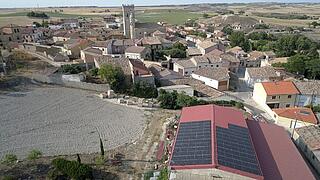Revised methodologies under the EU Carbon Certification Removal Framework continue to lack integrity

CRCF methodologies should be improved
© plainpicture / Anke Doerschlen
The CRCF aims to create incentives for scaling carbon removals within the European Union to help achieve the EU’s nationally determined contribution (NDC) under the Paris Agreement. The regulation will make carbon removal and soil emission reduction units available to buyers and thereby aims to generate funding for carbon removal activities in the EU.
In September and October 2024, the European Commission presented the first draft methodologies for certifying different types of mitigation activities. The methodologies specify how CRCF units should satisfy the four quality principles under the CRCF: additionality, quantification, permanence and sustainability. In a blog and detailed assessments published in November 2024, we found that the proposed methodologies could generate low quality units and undermine the EU’s climate mitigation efforts. Based on feedback from an Expert Group, the Commission presented revised methodologies in March and April 2025. In this blog, we summarize our analysis to what extent the methodologies have been improved.
Quality comparable to avoided deforestation projects using the older Verra methodologies
In our assessment, the revised methodologies have been improved in some areas but continue to fall short on basic integrity principles and do not build on the wealth of experience and lessons learned with existing carbon crediting schemes. Over the past 25 years, Oeko-Institut researchers have reviewed hundreds of methodologies and numerous carbon crediting programmes. The proposed CRCF methodologies are among the lowest quality methodologies that we have reviewed so far.
The methodologies set a considerably lower standard than the Article 6.4 Paris Agreement Crediting Mechanism (PACM). They also fall short of the criteria developed by non-governmental initiatives that aim to address integrity concerns in the voluntary carbon market: the methodologies do not fulfil key criteria of the Integrity Council for the Voluntary Carbon Market (ICVCM), a multi-stakeholder initiative to address integrity in the voluntary carbon market, and do not fulfil medium or high score criteria of the Carbon Credit Quality Initiative (CCQI), an initiative founded by Oeko-Institut, Environmental Defense Fund (EDF) and WWF-US to provide transparent information on the quality of carbon credits. In key areas, the methodologies even set a lower standard than the Clean Development Mechanism (CDM) which the EU banned from use under its emissions trading system (ETS) due to integrity concerns. Overall, we fear that the quality of units generated with the proposed CRCF methodologies could be comparable to those from avoided deforestation projects using older Verra methodologies, which led to considerable over-crediting due to inflated deforestation baselines. Concerns with the quality of these credits have considerably undermined confidence in the voluntary carbon market and led to a price crash for such credits. If the EU does not change its course of action, the same fate could happen to CRCF units.
Here we compare key requirements in the CRCF methodologies with the PACM and the CDM and provide recommendations how the methodologies should be improved. Where possible, we also provide an indication of how the proposed methodologies would score under the CCQI, which assigns scores from 1 (lowest quality) to 5 (highest quality) to carbon crediting programme rules and methodologies.
Do not reward past climate action
The revised methodologies continue to allow CRCF units to be issued for actions taken in the past, though time bounds were introduced in some of the methodologies. These past actions were undertaken regardless of the incentives provided by the CRCF – and are therefore not additional. For this reason, the PACM and the CDM both limit eligibility to those activities that have notified or publicly documented their intention to receive credits prior to the decision to proceed with the mitigation activity. This practice should also be implemented under the CRCF. Under the CCQI methodology, the practice of the CRCF corresponds to a score of 1 or 2, depending on the methodology, whereas the approach of the PACM and CDM corresponds to a score of 5.
Introduce robust additionality tests
Compared with the previous versions, some methodologies include slightly improved additionality provisions. First, some methodologies that used a standardized approach to additionality demonstration, such as the tree planting methodology, switched to an activity-specific approach. This is a more robust approach, as a standardized approach is not well suited for such activities.
Second, additionality tests for methodologies that use activity-specific baselines now more closely align with the rules of the PACM. In several instances, however, they leave out critical details or introduce derogations from key PACM provisions, which make the CRCF additionality test less stringent and in some cases even ineffective to filter out non-additional activities.
To give an example, the revised additionality tests now include a welcome requirement for activity proponents to implement them in a conservative manner, using verbatim language from the PACM rules. However, the tests only include half of the PACM requirements and leave out the critical part, which specifies that for ensuring conservativeness, operators must perform sensitivity analyses to confirm that their conclusions are robust to reasonable variations in critical parameters and assumptions.
Another example is the derogation from the requirement to conduct a financial analysis to demonstrate that revenues from CRCF units are necessary to make activities financially viable. Such requirements are vital for filtering out non-additional activities and they are a key part of the PACM’s additionality test. The proposed CRCF methodologies exempt operators from this financial analysis if they already receive public subsidies for the proposed activities [additional remark: the exemption only applies if public subsidies contain a claw back mechanism which requires operators to return part of the subsidies once other resources become available for the activity] or use CRCF funding to expand the scope of existing activities. However, the rationale for these derogations remains unclear. The fact that operators already receive public subsidies for an activity does not provide an indication of whether the activity would be financially viable without CRCF funding. Moreover, if CRCF revenues replace public subsidies, additional removals will only occur if the freed-up subsidies are used to support other removal activities. If these funds are redirected to general budgets, the CRCF will not incentivise any new removals on a net basis. The PACM rules do not include such derogations. On the contrary, they require operators to demonstrate that public funding would not have filled the financing gap in the absence of PACM revenues for cases in which public funding has a higher share than the expected PACM revenues.
While improved, the many derogations in some methodologies create high risks that many activities could receive CRCF units that are not additional. If non-additional CRCF units can be used to offset emissions in other sectors, this will result in higher overall emissions to the atmosphere. However, even if CRCF units are not used for offsetting, but rather as a tool to disburse funds, such funds should be allocated to mitigation activities that truly need them, rather than rewarding business-as-usual.
Revise accounting of biomass
The proposed methodologies give credit for enhancing the storage of biomass – in geological reservoirs through biomass carbon capture and storage (Bio-CCS) and in soils through the application of biochar. Removals occur as biomass grows in forests or on agricultural land. However, harvesting more biomass in order to store it in geological reservoirs or soils does not necessarily bring about a climate benefit. Shifting carbon from one pool (forests) to another (soils or geological reservoirs) may not result in any removals; rather, it could actually increase emissions due to losses in processing the biomass and the energy required to produce biochar. Similarly, simply diverting biomass from its current use (e.g. co-firing in a coal power plant) to a new use (e.g. biochar production) may not result in additional climate benefits.
The PACM and the CDM both require considering these effects. Both mechanisms only allow crediting the use of biomass, and accounting for it as zero emissions, where it can be demonstrated that the biomass would otherwise not be used or stems from newly established dedicated plantations. By contrast, the CRCF assumes a baseline of zero for biomass, without establishing eligibility conditions that ensure that the biomass would not be used in the baseline scenario or is generated from sustainably managed new forests that are established on unused degraded land. Under the CCQI, the approach towards biomass accounting would likely result in a score of 1 for the CRCF methodologies.
Revise quantification approaches to avoid over-crediting
The revised methodologies still lack robust approaches for quantifying removals and soil carbon emission reductions. For example, the methodologies continue to provide considerable flexibility in how removals or emission reductions may be quantified. In some methodologies, project operators may choose which emission factors to use instead of being required to use conservative default values. It is well documented that this can lead to a systematic selection of quantification methods that result in more credits.
All the revised methodologies continue to fail to account for indirect land-use change. Indirect land-use change can be a major source of emissions. For example, rewetting of peatlands or planting of trees on land that was previously used as crop- or grasslands could lead to relocating these agricultural activities elsewhere. This leakage resulting from such shifts could in some instances fully outweigh the emission reductions or removals achieved within the project boundary. Both the Article 6.4 mechanism and the CDM require preventing or accounting such leakage effects. Furthermore, the methodologies allow biomass used for BioCCS or biochar activities to be sourced from outside the EU, which further increases the risks of indirect land use change.
The biochar methodology does not require using state-of-the-art technologies to produce biochar, which may lock-in GHG intensive practices and undermine the ability of the EU to achieve its future climate targets. The methodology should specify that venting of methane is prohibited, that no fossil fuels be used in the biochar production plants and that biochar shall be produced based on pyrolysis, as other processes have too low temperatures to ensure that the biochar is stable over long time periods.
Lastly, the methodologies should more clearly separate whether they involve removals or emissions reductions and assign units accordingly.
Clarity needed on responsibility of CRCF methodologies and certification schemes
We also note that some methodologies delegate the responsibility for addressing key methodological issues, such as accounting for the priming effects for biochar, to the certification schemes. However, there is no clarity in the CRCF regulation on how the methodologies adopted by the Commission would be combined with any additional methodologies or methodological requirements developed under the certification schemes. The approach regarding which elements are addressed in CRCF methodologies and which elements are addressed in complementary methodological guidance provided by certification schemes appears to be inconsistent and arbitrary. Sometimes, details are prescribed in the CRCF methodologies whereas major methodological choices are left to certification schemes. We recommend that the methodologies do not delegate methodological matters certification schemes. The methodologies should be stand-alone documents that lay-out an EU-wide standard. Delegation of methodological matters is also incompatible with provisions of the CRCF regulation, which requests the Commission to specify detailed quantification methodologies.
In the farming methodologies, many sections also require further elaboration in order to contain clear and unambiguous instructions. Requirements are often formulated as general principles, but it remains unclear how compliance with these requirements should be demonstrated and be assessed by auditors.
Provide appropriate approaches to address non-permanence
All eligible carbon farming activities under the CRCF are subject to the risk that the stored carbon could be released again at a later point in time, due to human-induced interventions (e.g. harvesting) or natural disturbances (e.g. forest fires). However, the provisions on storage monitoring and liability in the carbon farming methodologies are insufficient. Incentives to maintain achieved removals over long time periods are missing, the proposed risk assessments do not consider avoidable risks and no consequences for ceasing the monitoring of carbon storage are defined. It is also not clear how temporary credits from carbon farming activities will be replaced when they expire. The methodology for peatland rewetting assumes that the emission reductions and removals are permanent. While the risk may be lower than for other project types, all emission reductions or removals could be reverted if the land would be drained again in the future. Overall, the approaches to non-permanence require considerable revision and further elaboration. Under the CCQI, no scores could be awarded, as the CCQI evaluates common approaches to address non-permanence. None of these common approaches are in place under the CRCF as it is not clear how temporary credits from carbon farming activities must be replaced upon their expiry and their use cases are not defined.
Without fundamental improvement of the methodologies, the CRCF could seriously undermine EU climate action
The shortcomings of the CRCF and the proposed methodologies could undermine the EU’s ability to fulfil its removal targets and ultimately its Nationally Determined Contribution (NDC) under the Paris Agreement. This is particularly the case if the units became eligible for compliance purposes, such as under the EU Emissions Trading System (ETS) or the EU Effort Sharing Regulation (ESR). But even if the units were only used to disburse funds to farmers or foresters, such funding would be ineffective: due to the lack of robust additionality rules, the funding would mostly be provided for business-as-usual. As there is no cost to continuing with business-as-usual, this would create a 'lemons market' in which business-as-usual activities would outcompete those activities that urgently need the funding to move forward. Not only would the scheme create ‘hot air’ units, it would also fail to provide the necessary incentives to enhance removals and reduce soil carbon emissions in the EU. The revised methodologies are not fit for purpose and must be fundamentally improved to help the EU to deliver climate action.
The underlying assessments were commissioned by Carbon Market Watch. The assessment and this blog represent the views of the authors only and not necessarily the views of Carbon Market Watch.
This blogpost was written by Lambert Schneider, Anne Siemons and Felix Fallasch.
Further information
Policy Brief "Second assessment of the draft technical specifications - Biochar" by Oeko-Institut






